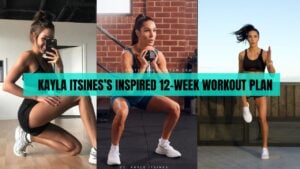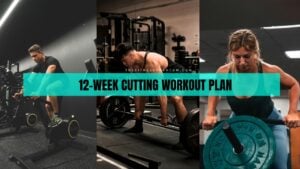The pull-up bar is the best gym equipment for building a stronger body. It helps develop multiple upper body muscles, including the abdominals.
The abdominals are the midsection of the body that supports the torso, helps keep the posture upright, and is involved in various lifting and sporting activities.1 Lee M, Han G. The effect of peculiar complex core balance training on isokinetic muscle functions of the knee and lumbus. J Phys Ther Sci. 2016;28(4):1294-1297. doi:10.1589/jpts.28.1294
Training the abdominal muscles using the pull-up bar isn’t easy, especially for beginners and overweight people.
But, if you have been exercising for a while and want to hammer your midsection using the pull-up bar, this blog is for you.
In this article, I’ll show you the following pull-up bar ab exercises that you can incorporate into your training plan to build a stronger core and thicker six-packs.
- Hanging Bicycle
- Oblique Twist
- Hanging Leg Lifts
- Hanging Knee Raise
- Toes To Bar
- Isometric L-hang
- Windshield Wipers
- Knees To Elbow
- Side Knee Raise
- Hanging Leg Circles
These exercises work the entire midsection, including the rectus abdominis (6-pack abs), transverse abdominis (deepest core muscle), and obliques (side abs), and build a solid center.
10 Best Pull-Up Bar Ab Exercises to Develop a Stronger Core

1. Hanging Paddle Crunch
The hanging paddle crunch, hanging flutter kicks, or hanging scissor kicks (three names of the same exercise) are abdominal strengthening exercises that you can do on the pull-up bar.
It involves keeping your legs lifted at your hips level and paddling your legs. This movement keeps your core engaged throughout and helps you build a stronger abdomen.
Instructions to perform hanging paddle crunches:
- Get on a pullup bar with your hands slightly wider than shoulder-width apart.
- Hold the bar firmly, and hang straight.
- Raise your legs at your hips level so that your body forms an “L” shape.
- Keeping your abdominal muscles engaged, bring your one knee in as the other knee goes out (like a bicycle pedal motion).
- Perform each rep in the controlled range of motion and complete two sets of 10 reps each.
Important Tips: Keep your legs straight down and pedal your feet down instead of at the hips level to make it easier. It can be a good one for beginners to start. And as you progress, you’ll be ready to perform the above one.
2. Oblique Twist

The oblique twist involves hanging on the bar and bringing your knees to the side of your chest. This twisting bolsters the internal and external obliques, improves core muscle definition, and enhances your hip mobility.
Here’s how to do it:
- Hang onto the bar with your hands slightly wider than shoulder-width apart, and your legs are straight downward.
- Now bend your knees and tuck them in front of your chest. After that, twist them to the right and then to the left.
- Then lower back down and again bend your knees raise at chest level and repeat the same steps as many times as you can.
To make it harder, twist both sides for the desired number of reps without dropping your legs down.
Important Tip: You can try one more variation, but it will be more challenging. To perform the harder variation, keep your legs straight in front of you instead of bending your knees. And then twist both sides as many times as you can without lowering your legs down.
3. Hanging Leg Raise
Strengthening the lower abs is one of the most challenging things to do. Only a few exercises help you do that, and a leg raise is one of them. The hanging leg raise fortifies the core (particularly the lower abs), improves balance, and thickens the rectus abdominis.2 McGill S, Andersen J, Cannon J. Muscle activity and spine load during anterior chain whole body linkage exercises: the body saw, hanging leg raise and Walkout from a push-up. J Sports Sci. 2015;33(4):419-26. doi: 10.1080/02640414.2014.946437. Epub 2014 Aug 11. PMID: 25111163.
Steps to perform the hanging leg raise:
- Get on a pullup bar with your hands shoulder-width apart.
- Brace your core and lift your legs in front of you until they are parallel to the ground.
- Then, squeezing your abs, pause for a moment, and return to the starting position.
- Aim for three sets of six to ten reps.
Important Tips:
- Do not bend your knees as you raise your legs upward.
- Perform each rep in a controlled manner to avoid excess body movement.
- Clamp a dumbbell between your feet to make this exercise more challenging.
4. Hanging Knee Raise
The hanging knee raise is an easier pullup bar abs exercise. And even if you can’t perform proper pullups, you also might be able to do this.
It primarily buttresses the lower abs, improves endurance, and enhances your six-pack appearance.
If you’re a beginner, doing knee raises prepares you for other advanced pull-up bar ab exercises.
How to perform hanging knee raise step by step:
- Hang onto the bar with your hands shoulder-width apart and legs straight downward.
- Keep your core, glutes, and thighs tight to maintain stability.
- Bring your knees toward your chest until your abs are fully engaged.
- Hold there for a moment, and then extend your knees.
Important Tips:
- Raise your legs while keeping your hips stable to get a better contraction.
- Secure a dumbbell between your feet to make this move more effective.
- Keep your arms straight, wrists neutral, and soft bend in your elbows throughout the movement.
5. Toes To Bar
The toe to the bar is an advanced ab exercise. It involves lifting your legs all the way until your feet touch the bar. This helps bolster multiple muscle groups simultaneously, primarily the lower abs and builds a stronger core.3 Aydın, Erbil & Gündoğan, Burak & demirkan, Erkan. (2023). Comparison of Muscle Activation During Toes to Bar Movement Performed with Different Techniques. CBÜ Beden Eğitimi ve Spor Bilimleri Dergisi. 18. 242-249. 10.33459/cbubesbd.1227537.
The toes-to-bar involves the following steps:
- Hang onto the bar with your hands wider than shoulder-width apart.
- Keep your legs straight and together.
- Firmly hold the bar, keep your ab muscles tight, and lift your legs so that your toes touch the bar.
- Make sure to engage your lats as you lift your legs toward the bar. Then slowly lower your legs back to the beginning position. Repeat this exercise as many times as you can.
Important Tips:
- To get more contraction in your abs, keep it slow and strict.
- You can make this exercise easy by driving your hips first, then extending your legs up.
6. L hang
The L hang is an isometric ab workout that involves staying in a static position for a certain duration. It improves your core endurance, provides a nice stretch to the upper body, bolsters your grip strength, and helps you build six-pack abs.

Here’s how to do it L-hang effectively:
- Get on the pullup bar with your hands wider than shoulder-width apart, palms facing away, and your legs straight and together.
- Raise your legs upward until they are parallel to the ground (your body forms an “L” shape). Do not bend your knees as you lift your leg.
- Hold in this position for as long as possible and make sure your abs are fully engaged.
Important tips to maximize core engagement: Keep your glutes, legs, and abdominals tight during the entire hold. This position prevents your lower back from arching and creates a nice contraction in your abs.
7. Hanging Windshield Wipers
The hanging windshield wiper is one of the toughest pull-up bar exercises. It involves lifting your feet up against the ceiling and rotating your legs to your sides. This position keeps your abs under constant stress and develops core endurance.
It also reinforces other muscles, including hips, shoulders, and arms, making it an excellent exercise to improve strength and stability.
How to do Hanging Windshield Wipers:
- Hang on the pullup bar with your hands wider than shoulder-width apart and palms facing away. Keep your leg straight and, together with your feet, facing downward.
- Raise your legs toward the ceiling until they are horizontally straight.
- Keeping your legs straight, rotate them from side to side as many times as possible.
A Tip for Beginners: You can slightly bend your knees and then twist from side to side to make it easier. Try and see if you can do it or not.
8. Hanging Knee To Elbow
This is an easier variation of the toe-to-bar ab exercise as it involves bringing the knees toward the elbows instead of lifting your legs up to the bar, helping you activate the core muscles deeply and effectively.
Steps to perform the hanging knees to elbows:
- Hang on a pullup bar with your hands wider than shoulder-width apart, and your legs are straight and together downward.
- Firmly hold the bar, keep your ab muscles tense, and lift your legs all the way up so that your knees touch your elbows or come close to your elbows.
- Make sure your lats are engaged as you lift your knees toward your elbows. And then slowly lower your legs back to the beginning position. Repeat this exercise as many times as you can.
Crucial Tips for Greater Core Engagement: Use the TUT (Time Under Tension) technique to force your abs to work harder and induce abdominal hypertrophy.4 Wilk M, Zajac A, Tufano JJ. The Influence of Movement Tempo During Resistance Training on Muscular Strength and Hypertrophy Responses: A Review. Sports Med. 2021;51(8):1629-1650. doi:10.1007/s40279-021-01465-2 You can do that by returning your legs to the start as slowly as possible.
9. Hanging Side Knee Raises
The side knee raises are the best pull-up bar exercise to train oblique muscles. It involves twisting your hips and lifting your knees to the sides of your stomach, helping build stronger obliques and a sculpted waistline.5 Nakai Y, Kawada M, Miyazaki T, Araki S, Takeshita Y, Kiyama R. A self-oblique exercise that activates the coordinated activity of abdominal and hip muscles – A pilot study. PLoS One. 2021;16(8):e0255035. Published 2021 Aug 12. doi:10.1371/journal.pone.0255035
To perform the side knee raises, hang onto the bar with your hands shoulder-width apart and do the following steps:
- Brace your abs and keep your legs together. That’s the start.
- Twist your hips and lift your knees toward your side stomach simultaneously until your obliques are fully engaged.
- Lower your knees slowly then repeat on the opposite side. That’s one rep.
- Aim for higher repetitions.
Progression Tip: Place a dumbbell between your feet for additional resistance.
10. Hanging Leg Circles
The hanging leg circles are a pull-up bar exercise for strengthening the core and lower body. It primarily targets the abdominal muscles, enhances core strength, improves hip mobility, and can help build a stronger, more stable core.
Performing hanging leg circles involves hanging from a bar and lifting your legs in controlled circular motions. This also helps you improve your grip strength and teaches you to control your bodily movement.
Steps to perform hanging leg circles effectively:
- Grab the pull-up bar with your hands shoulder-width apart.
- Slightly pull yourself up and keep your legs straight and together.
- Brace your core, raise your legs in front of you until they are at your hip level, and make a circle with your legs while returning to the start. Aim for higher reps.
Important Tip: You can also make circles with your legs during the lifting phase as well as while lowering them back to the start. It requires more core engagement, hence better contraction.
Let’s Create a Pull-Up Bar Ab Workout Routine
You’ve got almost every crucial ab exercise that you can do on a pull-up bar. But that’s not enough because you also need to structure them in a way that can yield better results.
I’ve created a few samples that you can try:
Routine A (Easy)
- 10 Hanging Knee Raises
- 10 Side Knee Raises or Oblique Twists
- 10-second Hanging L-Sit
- Perform as many rounds as possible.
Routine B (Moderate)
- 15-second Hanging Flutter Kicks/Leg Circles
- 10 Knees To Elbow
- 10 Side Knee Raises or Oblique Twists
- 15-second Isometric L-hang
- Aim for maximum rounds.
Routine C (Advanced)
- 15-second Hanging Paddle Crunches/Leg Circles
- 10 Knees To Elbow
- 10 Side Knee Raises or Oblique Twists
- 10-15 seconds Hanging L-Sit
- 10 Hanging Windshield Wipers (5/side)
- Repeat as many times as possible.
Final Words
Doing the ab exercises on the pull-up bar isn’t a cup of tea for everyone as they require excellent grip, forearm, and core strength. However, performing them will boost core strength, build six-pack abs faster, enhance sports and weightlifting performance, and reduce the risk of low back injuries.6 Willson JD, Dougherty CP, Ireland ML, Davis IM. Core stability and its relationship to lower extremity function and injury. J Am Acad Orthop Surg. 2005 Sep;13(5):316-25. doi: 10.5435/00124635-200509000-00005. PMID: 16148357, 7Leetun DT, Ireland ML, Willson JD, Ballantyne BT, Davis IM. Core stability measures as risk factors for lower extremity injury in athletes. Med Sci Sports Exerc. 2004 Jun;36(6):926-34. doi: 10.1249/01.mss.0000128145.75199.c3. PMID: 15179160.
Incorporate the following abdominal pull-up bar exercises into your workout regime and take your core strength to the next level.
References
- 1Lee M, Han G. The effect of peculiar complex core balance training on isokinetic muscle functions of the knee and lumbus. J Phys Ther Sci. 2016;28(4):1294-1297. doi:10.1589/jpts.28.1294
- 2McGill S, Andersen J, Cannon J. Muscle activity and spine load during anterior chain whole body linkage exercises: the body saw, hanging leg raise and Walkout from a push-up. J Sports Sci. 2015;33(4):419-26. doi: 10.1080/02640414.2014.946437. Epub 2014 Aug 11. PMID: 25111163.
- 3Aydın, Erbil & Gündoğan, Burak & demirkan, Erkan. (2023). Comparison of Muscle Activation During Toes to Bar Movement Performed with Different Techniques. CBÜ Beden Eğitimi ve Spor Bilimleri Dergisi. 18. 242-249. 10.33459/cbubesbd.1227537.
- 4Wilk M, Zajac A, Tufano JJ. The Influence of Movement Tempo During Resistance Training on Muscular Strength and Hypertrophy Responses: A Review. Sports Med. 2021;51(8):1629-1650. doi:10.1007/s40279-021-01465-2
- 5Nakai Y, Kawada M, Miyazaki T, Araki S, Takeshita Y, Kiyama R. A self-oblique exercise that activates the coordinated activity of abdominal and hip muscles – A pilot study. PLoS One. 2021;16(8):e0255035. Published 2021 Aug 12. doi:10.1371/journal.pone.0255035
- 6Willson JD, Dougherty CP, Ireland ML, Davis IM. Core stability and its relationship to lower extremity function and injury. J Am Acad Orthop Surg. 2005 Sep;13(5):316-25. doi: 10.5435/00124635-200509000-00005. PMID: 16148357
- 7Leetun DT, Ireland ML, Willson JD, Ballantyne BT, Davis IM. Core stability measures as risk factors for lower extremity injury in athletes. Med Sci Sports Exerc. 2004 Jun;36(6):926-34. doi: 10.1249/01.mss.0000128145.75199.c3. PMID: 15179160.






